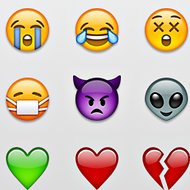Emoji: From Smiley Faces to a Great American Novel
Medical Pharmaceutical Translations • Dec 9, 2013 12:00:00 AM

Can you communicate in emoji? “Emoji” is a Japanese compound word meaning “picture” and “letter”. These symbols, which range from smiley faces to different foods and animals, started being shared by Japanese cell phone users in the late 1990’s. The rest of the world only got them on their phones, computers, and mobile devices a few years later.
Emoji’s origin explains one of their most distinct characteristics: while many symbols are easy to understand, others may be pretty mysterious if you’re not familiar with Japanese culture. For example, I felt really smart the other day when, by chance, I happened to see a picture of a snack food called onigri in a manga I was reading. I could finally tell my puzzled friends what the emoji that looks like a pyramid of rice is supposed to be.
Before I started using them, I thought emoji were the same as emoticons (smiley faces), but there’s a difference: the wide range of symbols means that people can actually tell entire stories with emoji, rather than being limited to just expressing emotions. Not that emoji messages are always easy to understand. In fact, deciphering them can be a difficult and frustrating task, as this short scene from the HBO series “Girls” points out so well.
Still, when done right (or maybe just when people know the context), emoji narratives can be effective and totally comprehensible. Take this early video version of Katy Perry’s hit song “Roar”, where emoji do the job of “spelling out” the lyrics. You might argue that the emoji lines in the video are easy to understand because there are some words interspersed with the images. But that’s not always the case. Here, for example, is the plot of the movie “Titanic” recounted entirely in emoji (spoiler alert, I guess…although you probably won’t understand if you haven’t seen the film).
The concept of retelling a tale entirely in emoji was taken even further by data engineer Fred Benenson, who decided to have volunteers translate each sentence of Herman Melville’s Moby Dick into emoji in 2009. The finished product, referred to as Emoji Dick, is the first emoji work to be accepted into the Library of Congress.
Is emoji the future of written language? I hope not. It’s a neat trick to see the beautiful, often-sober Moby Dick transcribed into brightly-colored, cheerful-looking symbols, but emoji obviously aren’t able to capture the subtlety and phrasing of Melville’s work, regardless of how cleverly some volunteers tried.
Nevertheless, if you think about it, emoji are a part of our linguistic heritage. Despite the evolution of writing systems, it seems there’s a part of us that will always be fascinated by pictograms. While they’re no longer used to record important information, we love to play with images and their corresponding sounds. For example, rebuses were all the rage in the 18 th , 19 th , and early 20 th centuries – and you can still find them today in the leisure sections of some newspapers, as well as online.
If all this has convinced you to give emoji a try, check online to see how to get them on your phone, computer, or mobile device. Many of these already have emoji built in, but if that’s not the case for you, you can probably download them. Once you’ve got the wide array of emoji at your fingertips, you can start sending messages to your friends and family. …Just keep that “Girls” clip in mind before you get too crazy, though….
#communication #crosscultural #emoji #globalcommunication #japanese #aiatranslations
